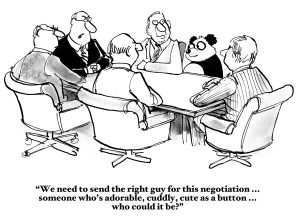Negotiation is a four letter word to some people, and a passionate love for others. Is negotiation part of the Project Manager’s role? It certainly is. In fact, without realizing it, the act of negotiating things on a project probably infiltrates just about every role occupied on a project … but it’s certainly most prevalent in the Project Manager role.

Reasons for Negotiation
Let’s take a look at reasons the need to negotiate may arise on an IT project.
- Functionality needed earlier than expected
- Out of scope work that needs to be included in current timeline
- Customer request for a different resource or skill set
- Data management issues and who handles them
- Customer training
- Budget issue vs. Timeline issue
The list can go on and on … these are just a few of the ones that I’ve personally run into on my projects.
Generally, the issues fall into one of these three categories:
- Timeline,
- Budget or,
- Scope (Covered in Part 2)
Unless the PM is being micro-managed from above by executive management or the PMO Director, the role of negotiator – at least from a customer-facing perspective, falls to the Project Manager.
This is the first of a two-part series on the need for negotiations with the project client from time to time. In this first part, we look closer at Timeline Negotiations and Budget Negotiations and how best to handle each type with your customer. Part two covers how to handle Scope Negotiations.
1. Timeline Negotiations
Negotiations on timeline issues can take on many forms. For me, the most common timing issue has been the request for functionality to appear earlier than previously expected. While this can sometimes be a major headache depending on the project, I try to take the phased approach if it is appropriate. By this I mean, negotiating with the customer on implementing functionality in phases. To do this, I follow these steps:
- Review the request for functionality
- Discuss with the delivery team experts
- Re-work an alternate project plan to move the requested functionality to early in the timeline
- Document a narrative for the customer outlining what needs to be pushed to later in the project to make it happen
- Conduct a formal meeting with both teams to present the proposal
Generally, my presented proposal consists of:
- Restructured priorities
- Moving the needed functionality to an earlier point in the timeline
- Implementing the functionality
- Creating later phases for the remaining functionality
It may also impact the budget, but if it gets the customer the functionality they desperately need when they desperately need it, then they’re probably very willing to accept the budget change it requires (this has always been my experience).
2. Budget Negotiations
The most common budget negotiations I’ve run into have been either:
- Higher-priced resources needed or requested on the project
If it is warranted by the project due to some undocumented needs by the customer, then I’ve often been able to ‘sell’ the customer on the higher-priced resource. If it’s the other way around – meaning the delivery organization wrongly assessed the resource needs, then the push needs to be to get senior management to agree to give your project the more skilled resource and bill the customer the same lower rate. As the PM, you still need to explain that to the customer – never miss an opportunity to gain additional customer satisfaction by letting them know you’re always fighting for them.
- The need for some unexpected customer training
In the case of the customer training… And it doesn’t have to be customer training – you can insert any one of a number of similar items here. But for me, it’s usually been customer training. The customer hasn’t realized the need for some training (usually due to a communication issue during the sales process), but it’s still needed and it isn’t cheap. Work with the customer and determine options. What’s worked for me, has been to coordinate with both the customer and the training department to price a training session on site for the customer rather than have the customer send everyone to the training department. This results in significant customer cost savings while bringing in new streams of revenue to departments in your own organization.
Part 1 Summary & Discussion Questions
I’ve mostly talked about the need for external customer negotiations. However, the need to negotiate also comes up regularly in your own organizations as you work to obtain resources, equipment, budget, and etc. The good Project Manager draws on experience from a history of customer dealings to enable them to effectively negotiate for things on their project with everyone involved in it.
How have you dealt with Timeline and Budget negotiations? What has worked, or not worked?
